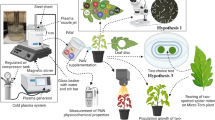Abstract
A 6-year study led to the development of a tomato seed treatment that controlledPseudomonas syringae pv.tomato (PT),Pseudomonas corrugata (PC),Xanthomonas campestris pv.vesicatoria (XV), andClavibacter michiganense subsp.michiganense (CM). Tomato seeds were immersed, at a ratio of 1:4 (w/v) seeds: chemical, in a solution containing cupric acetate, acetic acid, pentachloronitrobenzene, 5-ethoxy-3(trichloromethyl)-l,2,4-thiadiazole, and Triton x-100, for 1 h at 45±0.1 °C. The treatment was carried out in a thermostat-controlled bath circulator. The pathogens PT, XV and CM were almost eradicated after immersion of seeds for 30 min at 25 °C, whereas PC was controlled only after 1 h of treatment at 45 °C. The effectiveness of the treatment was related to the formation of a Cu2+ organic complex in the solution. The treatment did not affect seed germination or seedling vigor. Most of the tomato seeds produced or imported by Israel are now successfully treated by this method.
Similar content being viewed by others
References
Baker, K.F. and Smith, S.H. (1966) Dynamics of seed transmission of plant pathogens.Annu. Rev. Phytopathol. 4:311–334.
Bashan, Y. and Assouline, I. (1983) Complementary bacterial enrichment techniques for the detection ofPseudomonas syringae pv.tomato andXanthomonas campestris pv.vesicatoria in infested tomato and pepper seeds.Phytoparasitica 11:187–193.
Bashan, Y., Okon, Y. and Henis, Y. (1982) Long-term survival ofPseudomonas syringae pv.tomato andXanthomonas campestris pv.vesicatoria in tomato and pepper seeds.Phytopathology 72:1143–1144.
Buchanan, R.E. and Gibbons, N.E. [Eds.] (1974) Bergey’s Manual of Determinative Bacteriology. 8th ed. Williams and Wilkins Co., Baltimore, MD.
Chambers, S.C. and Merriman, P.R. (1975) Perennation and control ofPseudomonas tomato in Victoria.Aust. J. Agric. Res. 26:657–663.
Conlin, K.C. and McCarter, S.M. (1983) Effectiveness of selected chemicals in inhibitingPseudomonas syringae pv.tomato in vitro and in controlling bacterial speck.Plant Dis. 67:639–644.
Devash, Y., Okon, Y. and Henis, Y. (1980) Survival ofPseudomonas tomato in soil and seeds.Phytopathol. Z. 99:175–185.
Grogan, R.G. and Kendrick, J.B. (1953) Seed transmission, mode of overwintering and spread of bacterial canker of tomato caused byCorynebacterium michiganense.Phytopathology 43:473 (abstr.).
Grogan, R.G. and Kimble, K.A. (1967) The role of seed contamination in the transmission ofPseudomonas phaseolicola inPhaseolus vulgaris.Phytopathology 57:28–31.
Jones, J.B., Jones, J.P., Stall, R.E. and Miller, J.W. (1983) Occurrence of stem necrosis on field-grown tomatoes incited byPseudomonas corrugata in Florida.Plant Dis. 67:425–426.
Katznelson, H. and Sutton, M.D. (1951) A rapid phage plaque count method for detection of bacteria is applied to the demonstration of internally borne bacterial infections of seed.J. Bacteriol. 61:689–701.
Kritzman, G. (1989) Detection, quantification and classification of soft rot erwinias associated with potato tubers.Phytoparasitica 17:205–219.
Kritzman, G. (1991) A method for detection of seedborne bacterial diseases in tomato seeds.Phytoparasitica 19:133–141.
Leben, C. (1983) Chemicals plus heat as seed treatments for control of angular leaf spot of cucumber seedlings.Plant Dis. 67:991–993.
Lelliott, R.A., Billing, E. and Hayward, A.C. (1966) A determinative scheme for the fluorescent plant pathogenic pseudomonads.J. Appl. Bacteriol. 29:470–489.
Lukezic, F.L. (1979)Pseudomonas corrugata, a pathogen of tomato isolated from symptomless alfalfa roots.Phytopathology 69:27–31.
McCarter, S.M., Jones, J.B., Gitaitis, R.D. and Smitley, D.R. (1983) Survival ofPseudomonas syringae pv.tomato in association with tomato seed, soil, host tissue, and epiphytic weed hosts in Georgia.Phytopathology 73:1393–1398.
McCarter, S.M. and Ratcliffe, T.J. (1977) Incidence of major diseases on tomato transplants produced in Georgia.Plant Dis. Rep. 61:129–131.
Meynell, G.G. and Meynell, E. [Eds.] (1970) Theory and Practice in Experiments: Bacteriology. 2nd ed. Cambridge University Press, Cambridge, UK.
Neergaard, P. (1977) Seed Pathology. Macmillan Press, London.
Pohronezny, K., Volin, R.B. and Stall, R.E. (1979) An outbreak of bacterial speck of freshmarket tomatoes in south Florida.Plant Dis. Rep. 63:13–17.
Saettler, A.W., Schaad, N.W. and Roth, D.A. [Eds.] (1989) Detection of Bacteria in Seed and Other Planting Material. APS Press, St. Paul, MN.
Scarlett, C.M., Fletcher, J.T., Roberts, P. and Lelliott, R.A. (1988) Tomato pith necrosis caused byPseudomonas corrugata n. sp.Ann. Appl. Biol. 88:205–114.
Schaad, N.W. [Ed.] (1988) Laboratory Guide for Identification of Plant Pathogenic Bacteria. 2nd ed. APS Press, St. Paul, MN.
Schaad, N.W. and Stall, R.E. (1988)Xanthomonas. in: Schaad, N.W. [Ed.] 1988 Laboratory Guide for Identification of Plant Pathogenic Bacteria. 2nd ed. APS Press, St. Paul, MN.
Schuster, M.L. and Coyne, D.P. (1975) Detection of bacteria in bean seedXanthomonas phaseoli.Annu. Rep. Bean Imp. Coop. 18:71.
Sharma, S.L. (1981) Control of black rot of cauliflower by hot water seed treatment and field sprays with streptocycline.Ind. J. Mycol. Plant Pathol. 11:17–20.
State of Israel. (1956) Compendium of Plant Protection Regulations. Ministry of Agriculture, Jerusalem.
Taylor, J.D. and Dudley, C.L. (1976) Seed treatment for the control of halo-blight of beans (Pseudomonas phaseolicola).Annu. Appl. Biol. 85:223–232.
Yunis, H., Bashan, Y., Okon, Y. and Henis, Y. (1980) Weather dependence, yield losses and control of bacterial speck of tomato caused byPseudomonas tomato.Plant Dis. 64:937–939.
Author information
Authors and Affiliations
Rights and permissions
About this article
Cite this article
Kritzman, G. A chemi-thermal treatment for control of seedborne bacterial pathogens of tomato. Phytoparasitica 21, 101–109 (1993). https://doi.org/10.1007/BF02980881
Received:
Issue Date:
DOI: https://doi.org/10.1007/BF02980881




